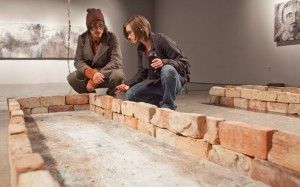Art reception expresses area social conflicts

February 10, 2013
The portraits and paintings of great floods and people long dead lined The Surplus Gallery’s walls Friday night for the art exhibit “Evicted From Heaven and Earth.”
The exhibit’s three undergraduate artists displayed their creations to audiences through the darkened Glove Factory gallery. Some artwork displayed ash and debris on canvas with bricks taken from King Tut’s tomb ruins, while others showed filmed reenactments of past rebellions in Cairo, New York City and London.
Husni Ashiku, a senior from Polo studying cinema, and one of the event’s artists, said all of the work done was to bring art back to its former glory by showing work that reflects society’s degradation.
Advertisement
“Evicted from Heaven and Earth” presents artwork that represents southern Illinois’ social conflicts,” he said. “The event expresses social problems including racial violence, natural disasters and women’s suffering.”
Ashiku said one of his pieces showcases burnt photographs that detail some of Southern Illinois citizens’ first memories.
“I went to Cairo and asked people what their first memories were in that town,” he said. “I went to the place where their first memory was at, and I took a photograph of that place as it exists today. I took (the photograph) and put it over a hotplate, and I had the recording of their first memory over the top of it. I chose this way because memory is always fleeting, just like cinema is always fleeting.”
Adam Turl, a senior from Carbondale studying art, said the exhibit’s goal was to show civilization’s decadence through art. Many paintings and sculptures don’t reflect the modern society well enough, he said.
“Life is a process of being alive, but also becoming something else — dead,” Turl said. “You lose everything eventually in life. That’s a constant, but the degree and timing of suffering, that’s something we make, too. It’s something that happens because of economic inequality, war, racism and political dictatorships. We wanted to reenact these things in sort of a ritualistic way.”
Two of Turl’s portraits depict men who were hanged in southern Illinois. One of the men, William James, was an African-American Cairo laborer who was lynched by an angry mob that accused him of a white woman’s murder a few blocks from his home. The other, Robert Prager, was a German-American coal miner hanged during World War I because of anti-German sentiment during the time.
While Turl and Ashiku focused on Southern Illinois events with their creations, Anna Maria Tucker, a senior from Marion studying art, said her work on women’s struggles is relevant within every culture. Her piece, “The Modern Moirai of Circumstance,” combined female hardship with the three Fates of Greek mythology: Clotho, Lachesis and Atropos.
Advertisement*
“My exhibit represents the role of women in society and how women of certain social income brackets still don’t have the same rights as men,” she said.
Tucker said the main idea she wants people to take away from her exhibit is women’s ability to control their fate more now than in the past.
Advertisement







